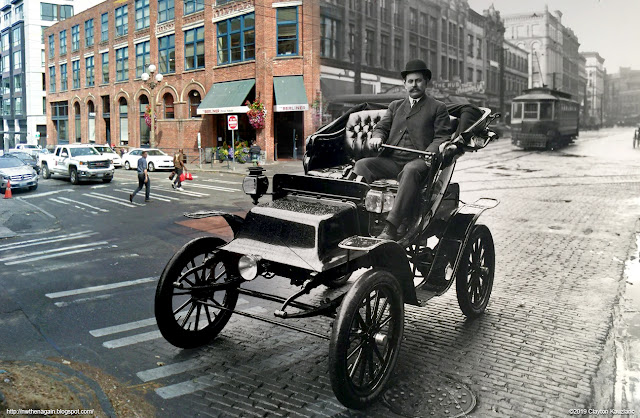Electric cars are an increasingly common sight on the streets of tech-heavy Seattle in 2019. But electric cars were, at least proportionately, more popular over a century ago. In 1912, gasoline powered only 22% of the cars sold in the US. Electric vehicles accounted for 38%. 40% of car owners opted for steam-driven conveyances. Americans of the time would have been familiar with dozens of automakers, big and small, most of which were history by the 1920s.
One brand that lasted longer than most was Studebaker. This Asahel Curtis photograph shows a shiny new 1908 Studebaker Victoria Phaeton electric. The photo was taken from the curbside by the Studebaker Brothers dealership at 308 1st Avenue. The Seattle Times from April 15th describes a Victoria Phaeton road test around the streets of Seattle. This picture was probably taken to commemorate the event and I think it’s likely the man behind the tiller is Marcus W. Kincaid, the dealership’s manager.
The goal was to see how many times the little electric could make the round trip from downtown Seattle to the top of Queen Anne Hill. It was a challenge many Seattleites could relate to. Not all roads were fully paved in 1908. The final regrade projects were still in the future so downtown had several taller, steeper inclines than what we see today.
The article describes a circuitous route, starting at Pike and 2nd, winding past Vine, 1st, Harrison and Queen Anne Avenue, ending at 6th Avenue West and Lee Street, declaring that the highest elevation. The car returned to the starting point using roughly the same route and repeated the trip. The Studebaker managed the seven mile round trip four times with enough charge left over “to run around town for some time afterward,” proving that the cars were “quite suitable” for residents of Queen Anne Hill, going on to state that “no one would have occasion to make more than four round trips down town in a day.”
Anyone needing that unlikely fifth trip would have to take a trolley like the one seen in the background of this photo -- or maybe one of the 80,000 horses residing in Seattle at the time.
CK


